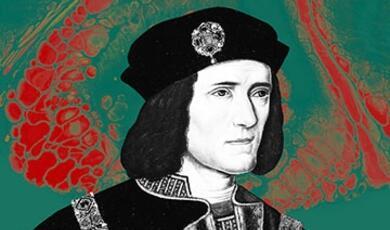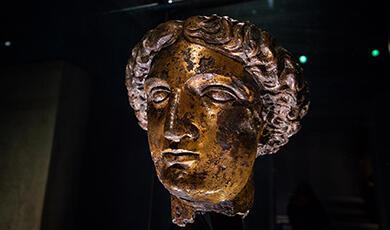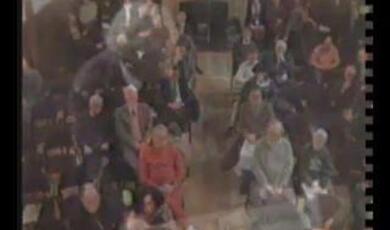The Historic Collections of St Paul's Cathedral
Share
- Details
- Transcript
- Audio
- Downloads
- Extra Reading
The historic collections have undergone some interesting developments in recent years. We will learn of new insights that have been revealed, and the roles of the library, architectural archive and object collection in the Cathedral's life.
This is the eighth in a series on Special Collections. The other lectures in this series are on the following collections:
Anatomy Museums
The Guildhall Library
British Architectural Library, RIBA
The Library and Archives of the Society of Friends
Lambeth Palace
Scotland Yard's Crime Museum
The Royal Horticultural Society's Lindley Library
Download Transcript
12 June 2013
The Historic Collection of St Paul’s Cathedral
Simon Carter
“Manifold and multiform are the materials from which ecclesiastical history are written”
Thus wrote W. Sparrow Simpson (1828-1897), Sub-Dean and Librarian of St Paul’s in his catalogue of St Paul’s Cathedral Library published in 1893. This is a very neat and polite way of saying that ecclesiastical collections can be a bit of a mess. And when you realise that this was expressed by a man attempting to compile a catalogue and impose some order on a cathedral collection it is a wonder he was so restrained.
It is certainly true that the items which form St Paul’s Cathedral Collections today can appear a very curious and eclectic ensemble. Many things, at first glance, seem to bear little or no relationship to one another, or to ecclesiastical history for that matter; they can range in type from alms dishes to historic wallpaper; a radiator to a reredos.
However, despite the diversity of the Collections there is an underlying unity. Each item has at some time, directly or indirectly supported the life and work of St Paul’s Cathedral or in some way helps to record and interpret it. Many of the items remain in regular use while others removed, at least for the time being, to stores, provide valuable reference to the continuity of the Cathedral’s mission and associated activities.
The words iconic dome are an endlessly repeated coupling and this may reflect that, for many people, the building is simply a familiar silhouette: seen on the way to work, in the opening sequences of the news or in Hollywood blockbusters where it affirms that the action is taking place in London. But there is of course much more to St Paul’s than its memorable, spherical cap and the collections are largely the product of what has gone on under or near to it for over 1400 years; a life that has witnessed Catholic and Protestant worship, celebrations, protests, executions, civil war, cataclysmic fires and innumerable events of national significance.
The nature of the collections is a testament to this long and varied life. It should however be noted that they do not offer a comprehensive or even balanced record of the history of the site since the foundation of the first Cathedral in 604 AD. The earliest surviving items date from Roman London, the early and later medieval periods are represented, however the preponderance of the Collections unquestionably relates to the Wren Cathedral. The strengths and weaknesses of the collection, what is present and what is missing, reflect a mixture of luck, foresight and the enthusiasm, whims, and sometimes the neglect, of those variously responsible for the care of the Cathedral over hundreds of years.
There is no doubt that in the course of the busy working life of the building, items which might have been disposed of have been kept, while conversely items which should perhaps have been retained have been let go. Yet despite this apparent lack of organised collecting and disposal various factors in play have ensured that the Collections retained by St Paul’s Cathedral today are a truly remarkable body of material. Together they form a unique record of the spiritual, liturgical, architectural, administrative and social life of one of the world’s outstanding buildings and its imposing predecessor the Pre-fire Cathedral (one of the great lost buildings of London).
The Cathedral has frequently stood at the heart of national events and communal acts of commemoration and perhaps as a result of this the administration has historically had an eye, if inconstantly focused, on its own history. In recent years however the way in which the Cathedral perceives its Collections has developed considerably, just as it has amongst interested external bodies and the general public. The Collections are recognised more than ever as not only important to the institution which houses them but also significant as part of a wider national life.
Thank largely to impetuous from Professor Michelle Brown one time Lay Canon at the Cathedral, the Cathedral Surveyor, Martin Stancliffe and the support of the Cathedral Chapter a Collections Department has developed – consisting of a librarian, an archivist, a conservator a collections manager and many volunteers who work together to ensure the long term preservation of the Collections and to maximise their potential as a resource. This structure helps us to prioritise conservation work and improve access to the collections and to information about them.
To try then, as Sparrow Simpson did, to apply some structure to these collections, I will present some highlights which I have arranged in three main categories: what there is, what there was, and more mysteriously, what might have been.
What there is- can be broadly divided into three main categories: The Library Collections, The Chapter Archive and the Object Collection.
The Chapter of St Paul’s have retained a working library in the present building since 1720. Following the Great Fire in 1666 (only three manuscripts and twenty-four printed books survived) the library was restocked by the Commissioners for Rebuilding St Paul's: they bought Collections, including valuable Bibles and liturgical texts, and received a generous bequest in 1712 (delivered 11 July 1715) of nearly two thousand volumes from the library of Henry Compton, the late Bishop of London. In 1783 the library of John Mangey, Vicar of Dunmow and Prebendary of St Paul's and of his father, was added. In the nineteenth century large Collections of ecclesiastical tracts and pamphlets were bought in and improvements made to the library's holdings of sermons preached in the Cathedral and at Paul's Cross.
The subject strength of the historical Collections lies in theology, church history and patristics. Dedicated collecting in these areas ceased in about 1880 and current acquisitions are now restricted to core administrative documents and some published items. The published items which are collected include major works on the history of the Church in England, Wren and the building of the Cathedral, the Church in the City, and material produced by the Chapter. Core administrative documentation includes service papers, chapter minutes, and Friends/Foundation publications.
Today the library houses approximately 21,500 volumes, including printed books, tractsand manuscripts. These works accrued through purchase, bequest and donation, largely from 1690 onwards, form a collection still used today by academics, students and researchers of all kinds.
William Tyndale’s New Testament – The first English Language Bible to appear in print is unquestionably the most significant item, not only in the library collection, but owned by the cathedral chapter.
The book, translated by the man recently dubbed Tudor England’s most dangerous man, was printed in Worms in Germany by Peter Schoeffer in 1525 whenthe very idea of an English language Bible was shocking and subversive. The volume was unorthodox in a number of ways: simply making the New Testament available in the vernacular was considered to undermine the role of the Catholic Church as the mediator between God and the people, with Priests interpreting the bible on behalf of their congregations; while the choice of the words which Tyndale employed in interpreting his Greek and Hebrew sources further emphasised his reformist views. For instance, he uses the word Congregation instead of Church; elder in place of priest; and repentance for penance.
None of his publishing or preaching activities endeared him to the ecclesiastical authorities in England.Under the 1408 Constitutions of Oxford, it was strictly forbidden to translate the Bible into the native tongue. This ban was vigorously enforced by Cardinal Wolsey and the Lord Chancellor, Sir Thomas More, in an attempt to prevent the rise of English ‘Lutheranism’. The only authorised version of the Bible was St Jerome’s Latin translation, known as the ‘Vulgate’, made in the fourth century.
Tyndale carried out his work as secretively as possible, moving several times in Europe to evade capture. Once completed the books were smuggled in to England and Scotland in bales of cloth, their pocket-book size making them easier to conceal. If discovered the books were burnt and the owners punished, with Bishop Tunstall one of the leading advocates of these practices. From this destruction the St Paul’s Tyndale New Testament is one of only three copies surviving from the 3,000 or more which were printed.
Tyndale himself did not escape the flames. He continued to needle Henry the VIII by opposing his divorce in a 1530 publication entitled The Practyse of Prelates and then made the mistake of living openly inAntwerp. He was befriended by an Englishman called Henry Philips, who professed an interest in the reformed faith. In fact, he was an agent - either of Henry VIII or the new English Church. He was betrayed, arrested and executed on or just before on 6th October 1536. You may think that this mix of covert activity, espionage and international politics would make a good thriller – and in 1986 a feature film was made of the story – God’s Outlaw!
The book is the great treasure of the library collection: however in keeping with its earlier status as contraband it arrived in the Cathedral surreptitiously; it’s true nature was not appreciated at the time that it came to St Paul’s purchased from Humfrey Wanley in 1710 as part of a collection of Bibles and liturgies. The leaves of the Gospels and epistles had been deliberately intermixed to ingeniously disguise the content of the book should it have been discovered. In the nineteenth-century this mixing of pages was curiously thought to have been undertaken since the endeavours of Bishop Tunstall to incinerate every copy he could find, and the sheets were rearranged in proper sequence and the volume was rebound, thus destroying what was, in all probability the original binding as well as the evidence of the method used to avoid detection in the early days of the reformation when the search for copies was so vigorous.
This tiny book has a huge cultural significance; it was the basis for the subsequent Standard English translations of the Bible. It is still greatly admired for the clear, poetic quality of the writing and an astonishing number of Tyndale's phrases are still in use today, including: 'broken-hearted', ‘gave up the ghost’ and the more up-beat: 'eat, drink and be merry'.
The second section in the What There Is category is the Chapter Archive. These documents relate to the constitution, administration, services, finances and fabric of the Cathedral; the Peculiar jurisdiction of the Chapter (including probate); and the estates of the Chapter and Cathedral officials. They shine a light on all manner of the aspects of Cathedral life, from seemingly mundane details, such as the cash books for charging entrance fees to records from moments of high drama, such as the Fire Watch Log Books, generated during the defence of the Cathedral during the blitz.
The oldest item in the Chapter Archive is a Charter of William II notifying his confirmation to the canons of St Paul’s of their rights of jurisdiction, over their property, dated 6th July 1099. It used to be the oldest document held in the City of London until its move to LMA where I am told it now holds only second place in the superlative stakes. Like much of the archive it relates to property and finance, a necessity for business continuity. Another notable document of this type is the Liber Pilosus, a cartulary from 1241, which lists theprivileges and legal rights of the Cathedral, and owes its name “the hairy book” to the deer skin binding which retains its ruddy bristles.
Owing to various pressures and exigencies the Chapter Archive is spread across a number of locations including St Paul’s Cathedral Library, St Paul’s Architectural Archive and it includes material which was previously deposited at Guildhall Library, but which moved at the beginning of this year to London Metropolitan Archives. Guildhall Library still retains a significant body of secondary source material for the history of St Paul’s.
The archive includes official administrative documentation, for example the Chapter Minutes which constitute the official record of the Cathedral’s activities – including the only surviving Medieval Chapter Act book for St Paul’s dating from 1411-1448. The Chapter Minutes from 1833 to the present are kept on site at the Cathedral for reference purposes to inform operations.
The personal papers and correspondence of Deans, Canons and others associated with the Cathedral give colour and background to the administrative documentation. It is a body of material which continues to grow. The daily life of the Cathedral rolls on, and sporadically, history pounds on the doors (sometimes literally), and when it has moved on, it frequently leaves in its wake a trail of questions and the material culture and memory from which the answers can be sought. The truth of events can be the subject of a tug-of-war. The official line is recorded, but having the personal account often helps to form a broader picture.
The Cathedral archives appear to have been well protected from damage during World War Two, and to have suffered little or no loss. However the same was not true of administrative books and papers which were too recent to have been added to the archives, and which may have been stored in the Chapter House. Any such papers perished when the Chapter House was destroyed by enemy action in 1940.
A conceptual subseries of the Chapter Archives are the architectural plans, drawings and reports which are retained by the Chapter.This material derives significance from the role it plays in the day to day maintenance of the building. It is a point of reference for the Clerk of Works and the Cathedral Surveyor and is regularly consulted to enable informed permissions applications and the maintenance and conservation of the building.
Because of the functional nature of the architectural archive, the most recent plans and drawings can be as useful if not more so than some more historic items. Older plans and drawings derive significance from their historical importance, describing the construction, decoration, life and work of St Paul’s. Many have considerable artistic merit in their own right. There are approximately seven thousand plans and drawings kept on site, which are supported by reports, photographic prints, negatives, printed and hand-written documents and digital records, largely generated by the Cathedral’s Surveyor’s, Clerks of Works and contractors.
The starting point for the Cathedral Architectural Archive are the 226Wren Office drawings and the building accounts which are now located at LMA. They have been the subject of a recent catalogue by Dr Gordon Higgott, who has identified the hand of each draughtsman and dated each drawing so that the phases of construction are now better understood than ever before.
Nicholas Hawksmoor was responsible for executing the majority of the drawings, and other highly skilled but less well known draughtsmen such a Edward Pearce and Edward Woodroofe made a significant contribution, working collaboratively under Wren’s overall control. The drawings constitute only a fraction of what must have been produced during the thirty five years of construction; however their existence nevertheless confirms St Paul’s as one of the best recorded great buildings of its period.
One of the chief surprises which Dr Higgott’s study of the drawings has revealed is that, far from being a fully developed concept in Wren’s mind, the design of St Paul’s evolved as construction took place, as a result of which, the important idea of a brick cone to support the Cathedral lantern, was only introduced in 1702, just seven years before the building was actually finished. Such an approach would be unthinkable in modern architectural practice.
The drawings themselves are deposited at London Metropolitan Archives, while reproductions are on display in the Cathedral’s Trophy Room, where they support the exhibition of Christopher Wren’s Great Model.
The Great model is one of the most significant items in the object collection and its close association with the drawings and building accounts demonstrates the inter-relationship which collections items retain in spite of the rather artificial but necessary management divisions which people like Sparrow Simpson and I try to impose upon them.
“Made to scale of 1:25", it represents the design of great magnificence and beauty, according to which, Charles II appointed Wren, by warrant of 12th November 1673, and directed him to build the cathedral. It was intended to be a permanent record, in case of accident to the architect, and to show, more clearly than sets of drawings could do, how everything fitted together.
It was designed to be walked through at eye-level to suggest the experience of the real interior. The model was made from full-size drawings scaled up by Wren and his assistant Edward Woodroffe, working at a large table in the Chapter House of the pre-fire cathedral. For most of its life it has been kept in the cathedral.
The model was completed by August 1674 at a cost of about £600, the cost of a good London house. Originally it was painted "stone colours" inside and out, with grey for the lead of the domes, gilded details and fictive relief. Wren made other designs for St Paul's both before and after the Great Model, all the time he was learning about the process of designing a cathedral and about the specific requirements of the one we have today.”
Kerry Downes
It is the earliest of over seventy architectural models in the Cathedral collections which have been used at various times to present decorative schemes, fixtures and fittings and to show how the building works.
They are form part of the third section of the What There Is category, theObject Collection. Within the Cathedral Object Collection there are some very remarkable and important items and artefacts. These are mostly three dimensional pieces but the category also includes paintings, prints and some drawings. For the purposes of compiling the Cathedral inventory in 2004 the Object Collection was organised into object categories and these provide a useful framework for considering the scope of this group of material: Altars and Fonts, Architectural Components, Bells, Casts, Church Plate, Clocks and Dials, Coins, Medals and Seals, Furniture, Monuments, Mosaics and Tiled Surfaces, Musical Instruments, Prints Drawings and Paintings, Sculpture, Textiles and Embroideries, Vessels and Ornaments and Vestments.
There are highlights in every one of these categories. Bell enthusiasts are awed by Great Paul, the largest bell in Great Britain, sixteen tons cast in 1881, anything related to the Cathedral Organ, originally made by Bernard Schmidt in 1697 but considerably altered, posted on You Tube is guaranteed thousands of hits, while embroidery specialists go in to rapture when they are confronted with the design and expert needlework of the Jubilee Cope.
Vestments and textiles are one of the areas of the collection which requires the most maintenance because they are in regular use. Different colours are worn to underline moods appropriate to a season in the liturgical calendar, for example: white for Christmas and saints feast days, red for Palm Sunday, green for Sundays in ordinary time. The form of copes, chasubles and stoles has changed little for hundreds of years however their design and the materials employed in their construction certainly reflect changes in fashion and taste.
The most recent addition to the collection of vestments was a complete set made by a team of highly skilled volunteers to mark the 300th anniversary of the Wren building, the design was the result of a competition among students at St Martin’s College of Art and drew inspiration from decorative elements in the Cathedral Collections.
What There Was
For over five hundred years another building dominated the site at the top of Ludgate hill, and were it not for the Great Fire of London and the Blitz it would perhaps still be in situ. It is not surprising to learn that, begun in about 1180 and at its fullest extent around 1550; it was one of the most impressive medieval buildings in Europe. What is surprising is its Houdini like disappearance. It was bigger than the present Cathedral in almost every dimension and yet only a tiny archaeological record remains, perhaps less than five percent. The Cathedral Collections retain drawings and reports from the archaeological investigations to find the foundations by the nineteenth-century Surveyor FC Penrose and a collection of stones which were excavated by him is displayed in the Cathedral Triforium; however the soaring columns, tombs, shrines fixtures and fittings have more or less vanished, for the time being.
Some of the medieval Church plate did survive the destruction of the pre-fire cathedral; this included chalices, patens and alms dishes as well as elaborate metal work book covers recorded in several cathedral inventories. However an audacious theft in 1810, denuded the Chapter of some of its most precious possessions, central to the daily rounds of worship practiced in the building. Not one piece has resurfaced since the theft which perhaps suggests that the precious stones were extracted and the metal was melted down. The plate (the essential equipment of the liturgy) has been replaced, with a collection mostly built up in the nineteenth-century with items such as the Butterly alms dish of 1871, however the theft was definitely one of the greatest single losses to have hit the Cathedral collections.
Were Queen Anne to return to the Cathedral she saw finished in 1710, she would no doubt recognise the exterior of the building as largely unchanged, but were she to enter through the Great West doors she would possibly be quite bamboozled by what she saw. For there has been a great deal of alteration, which reflects all kinds of influences on the life of the building, not least, the removal of the quire screen under the direction of Dean Milman, to open up the cathedral for larger congregations in the 1860s. This liberated a lot of Grinling Gibbons carving which has fortunately been retained in the Collections. There have also been many interventions which have come and gone since 1710, to which the returning Queen Anne would be quite oblivious: stained glass windows by the German Nazarene artist Julius Schnorr Von Carols Feld for example. Although they have disappeared from the Cathedral, the original designs remain in the archives, as well as photographs of them in place, and some fragments of them are in the object collection. One of the windows has reportedly found its way to the tropical climes of the Winward Islands. Remarkably, parts of the Cathedral have ended up all over the world.
What might have been?
It has been said that the Cathedral has the “engine of a lawn mower and the breaks of a juggernaut”. This conjures an entertaining image, but is overall an unfair comparison as the continuity of the life of the building over 1,400 years has required something far more robust to drive it on so consistently, however it does reflect the fact that major changes can take a while to be decided upon and when it comes to the crunch, some have been abruptly dropped after several years of consideration. This final mysterious category within the Collections relates to proposal which were never realised but which have nevertheless enriched the collections.
An excellent case in point is the decoration of the Cathedral, which in an earlier Gresham lecture by Martin Stancliffe, was picked out as one of the major themes to have troubled successive Chapters from 1710 onwards. The question of how to finish, or “complete” the interior in an appropriate way generated extraordinarily protracted deliberation and indeed, continues today. What would provide suitable images for contemplation? How didactic should the decoration be? How expensive would it be? Who should decide upon it?
Without recounting the full story, which is far from a straight forward narrative, I will focus on two of the most developed schemes in the collections – the first by Sir Frederick Leighton, Edward Poynter and Hugh Stannus, the second by William Burges and his draughtsman Axel Haig. The development of both of the schemes can be traced in the archive, library and object collection.
For Leighton’s scheme we retain, most significantly, a six meter in diameter, oil on canvas roundel of 1878, which was held up in the dome of the Cathedral to give a sense of the appearance of his proposed mosaic scheme. It draws inspiration from the Book of Revelation and depicts the Sea Giving up its Dead. It is the work of which Leighton was most proud and he went on to create a smaller version which can be seen in Tate Britain. Following its rejection at St Paul’s this roundel was rolled up and largely forgotten – its “rediscovery” should be an extraordinary boon for British art history. It requires considerable conservation work however and until funds can be raised, it remains rolled and unseen.
William Burges, best known for his gothic revival design work, put similar effort in to his proposal for St Paul’s. Over eight years he commissioned an architectural model, produced plans and reports and engaged Axel Haig to provide watercolour visualisations of his scheme in order to win over the commissioners. All of these are retained in the Cathedral collections. Together they provide a complete picture of Burges’ vision. There were innumerable complications, not least clashes of personality and the project concluded, Burges diary recording the termination with surprising stoicism.
Having thought about what is, what was, and what might have been, it is clear that, in-spite of Cathedral fires, civil and ecclesiastical iconoclasm, The Great Fire of London and the Blitz, a treasure trove has survived. Together the Cathedral Collections are a unique body of inter related material. In order to ensure that these collections continue to survive, to be enjoyed by future generations, the cathedral Collections Department is pursuing a list of prioritised preventive conservation measures and remedial conservation work to return items to a usable condition.
The acquisition of new items is now strictly limited to specific groups of material; and secure, regularly backed-up digital storage is favoured over the retention of hard copies of paper documents. Almost all areas of the Collections continue to grow; individual items are obtained for use in the working life of St Paul’s and significant bodies of material such as the Deans papers are deposited, not only to inform daily operations, but so that future generations can appreciate and engage with the life of St Paul’s.
Many areas of the Collections still require in-depth analysis by subject specialists in order to ascertain their full significance. But as this research work is carried out the structure is in place to manage this information and share it as widely as possible. With that overview of an immense and diverse collection: approximately 3,500 objects, 21,500 publications and over one hundred meters of archive, I’d like to end with another quote from Sparrow Simpson who succinctly captured the importance and wonder of the collections and the need to look after them appropriately:
“May there never be wanting loving hands and hearts to deal with the treasures stored within these walls: and to transmit to others the Golden Key that opens the Enchanted Door.”
© Simon Carter 2013
This event was on Wed, 12 Jun 2013
Support Gresham
Gresham College has offered an outstanding education to the public free of charge for over 400 years. Today, Gresham plays an important role in fostering a love of learning and a greater understanding of ourselves and the world around us. Your donation will help to widen our reach and to broaden our audience, allowing more people to benefit from a high-quality education from some of the brightest minds.


 Login
Login







